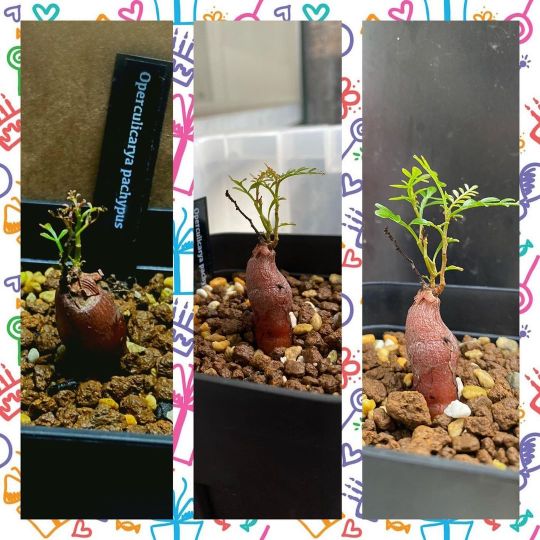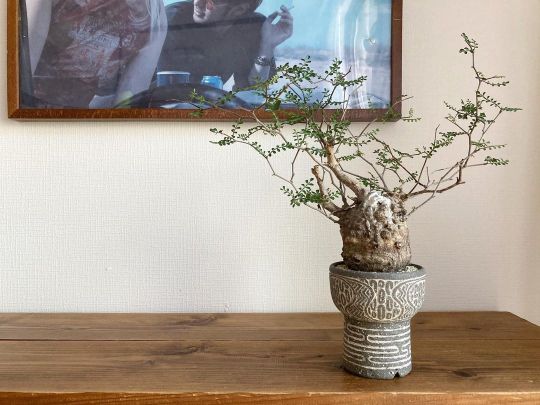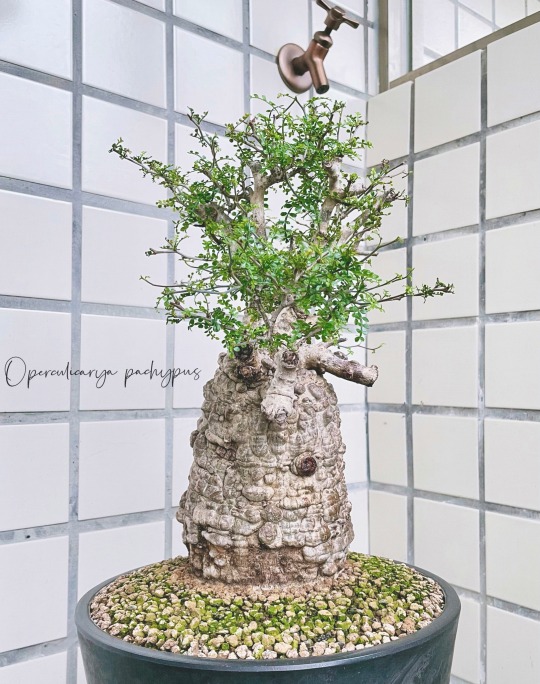#pachypus
Text

mathew's operculicarya pachypus on the way to sf, 2021
4 notes
·
View notes
Text

0 notes
Text
Pachypus operculicarya

#home & lifestyle#love#varigated#aroid#philodendron#monstera#home#sukulent#zamioculcas#pachypus operculicarya
0 notes
Link
Discovery of a novel merbecovirus cDNA clone contaminating agricultural rice sequencing datasets from Wuhan, China
Abstract
HKU4-related coronaviruses are a group of betacoronaviruses belonging to the same merbecovirus subgenus as Middle Eastern Respiratory Syndrome coronavirus (MERS-CoV), which causes severe respiratory illness in humans with a mortality rate of over 30%. The high genetic similarity between HKU4-related coronaviruses and MERS-CoV makes them an attractive subject of research for modeling potential zoonotic spillover scenarios. In this study, we identify a novel coronavirus contaminating agricultural rice RNA sequencing datasets from Wuhan, China. The datasets were generated by the Huazhong Agricultural University in early 2020. We were able to assemble the complete viral genome sequence, which revealed that it is a novel HKU4-related merbecovirus. The assembled genome is 98.38% identical to the closest known full genome sequence, Tylonycteris pachypus bat isolate BtTp-GX2012. Using in silico modeling, we identified that the novel HKU4-related coronavirus spike protein likely binds to human dipeptidyl peptidase 4 (DPP4), the receptor used by MERS-CoV. We further identified that the novel HKU4-related coronavirus genome has been inserted into a bacterial artificial chromosome in a format consistent with previously published coronavirus infectious clones. Additionally, we have found a near complete read coverage of the spike gene of the MERS-CoV reference strain HCoV-EMC/2012, and identify the likely presence of a HKU4-related-MERS chimera in the datasets. Our findings contribute to the knowledge of HKU4-related coronaviruses and document the use of a previously unpublished HKU4 reverse genetics system in apparent MERS-CoV related gain-of-function research. Our study also emphasizes the importance of improved biosafety protocols in sequencing centers and coronavirus research facilities.
#covid-19#sars-cov-2#biological WMD#print this off later#fav#wuhan institute of virology#Unrestricted Warfare#resident evil#Steven Quay
2 notes
·
View notes
Text
Among the most popular pet frogs, and among the most charming, are the fire-bellied frogs or toads - in the strictest sense, they aren't either - such as Bombina variegata, the yellow-bellied toad of the Western Palaearctic realm, and specifically Central and Southern Europe. This is a small and easily housed frog species, growing to a snout-to-vent length of 2.8 to 5.6 centimeters, or about 1 to 2 inches.
Within this species, racial differences exist in their markings across their geographical range. The northeastern populations are genetically distinct from their conspecifics in the rest of its distribution, to their west and their south. This deep divergence implies a pre-glacial common descent, and long isolation owed to climatic factors. For this species, the Carpathian Mountains were an ecological refuge, from uninhabitable Pleistocene climates. Also an Italian race of yellow-bellied toads, is often nowadays elevated to full species tank, as B. pachypus.
Bombina is a member of the costate frogs, a clade that also includes the well known genera Discoglossus and Alytes, the painted frogs and midwife toads. Costate frogs competently walk and hop, but they are not long-range jumpers. The costates are not only early diverging, but also protomorphic, retaining unspecialised pelvises that reflect their locomotor conservatism. It is the rearrangement of the pelvis in certain, unrelated frog clades, that allows such derived frogs to jump perfectly.
Bombina sp. are collectively known as the fire-bellied toads, because of their easily visible, yellow to red underbellies. As in those newts with a similar ventral coloration, this has evolved as an aposematic warning, or an advertisement of their toxicity to deter potential predators. To make obvious their coloration, these amphibians display their bellies when they are threatened by a larger carnivore, by flipping onto their own backs, or by employing the body language of raising up - this is the famous 'unken reflex'.
The species of Bombina are distributed from Europe across to Siberia and down beyond China. They are truly a Palaearctic faunal component, but their distribution is non-continuous, which is a result of ancient climate changes. There is an early divergence within the genus Bombina, separating a southern subclade, known as the B. maxima complex, and also a secondary division within the more northerly group, into the European group and the eastern B. orientalis.
At lower elevations, B. variegata lives in deciduous forests, whereas in higher terrain it is a denizen of conifer forests. A habitat generalist, B. variegata utilities diverse lentic and lotic waters. Relative to a sometimes sympatric Bombina species, B. bombina, it eats more terrestrial arthropods than aquatic prey in the wild. This fact allows for some niche partitioning where both species of Bombina are present in the wild.
Although the two species of fire bellied frog are quite distinctive in their looks and vocaluzations, they hybridize readily. However both morphospecies remain distinct, owing to natural selection disfavoring the fertile hybrids that result from these pairings. Thus in the case of these two Bombina species, racial mixing does not result in de-speciation through hybritity, nor has it resulted in the evolution of a new species from the hybrid stock.
B. variegata inhabits temperate, seasonal climates and the daily temperature it experiences, can shift by up to 10 degrees in the course of a day. A study of a B. variegata locality, found that the water temperature was 4 to 24 degrees centigrade, depending on the season. Whilst the air temperature there was 3-31 degrees. (At other localities where B. variegata is present, the water temperature may itself be 31 degrees.) Their season of activity begins at 8-10 degrees centigrade
B. variegata and other Bombina species need to have only shallow water provided for them, because they do not make deep dives for their food. Ideally, these anurans should be able to stand on their toes, reaching up so their faces are above the water. These anurans receive UV wavelengths as daylight in the wild, and benefit from a UVB emitting light source in the aquaterrarium. Bombina sp. do not damage live plants, and are thus suited to a planted aquaterrarium.
Some people have successfully cohabited Bombina sp. with other animals species, but there are risks. These frogs can reflexively lunge at animals that are perceived prey, and their glandular skins are themselves toxic, possibly creating problems should other animals come into contact with their skins. Nonetheless, similarly sized climbing animals, like tree frogs and anoles have been cohabited with Bombina sp. because they inhabit different areas of the enclosure, which minimizes interactions. Regarding conspecifics, male Bombina sp. may be aggressive to one another. The males of these frogs, have longer forearms than to the females.
However, on the down side, Bombina sp can (sometimes) be difficult to feed on a proper captive diet. Often, Bombina adapt to taking items such as floating sticks. Therefore it is untrue that their intended food needs to move, without which the feeding response cannot be stimulated. However, this does not mean that all individuals in these species, are equally willing to do so.
Non-living items in the water are more likely to elicit a feeding response, because chemosensory cues travel better through water than through air, however, contrary to popular factoids, it has also been argued for decades that frogs can see non-moving items, and recognize them as food. I am aware that frogs belonging to distantly related taxa, can and do eat pre-killed prey - these are costates, pipids, bufonids, hyloids, and ranoids.
It is widely reported, and I can see no reason to doubt it, that the species of Bombina differ in their temperature tolerances and optimums. All species of Bombina should be fine at cool room temperatures year round, in a cool temperate climate. That is to say, when and where it is suitable for humans to live comfortably, without feeling hot.
Despite being quite southern in its origin, the popular giant fire belly species, B. maxima from high altitudes in southern China, is said to require lower ambient temperatures, than do the European species. But I know for a fact that B. maxima can be acclimatized, like members of the more northern clade, to an ambient temperature of 24 or 25 degrees centigrade. And I am positive that these frogs encounter such temperatures, which are scarcely soaring, in their wild, subtropical latitude habitats.
Although the B. maxima species complex, which extends to Taiwan and northern Southeast Asia, include the largest of the fire bellied frogs, but even they are not huge. It is rare for individuals to exceed 6 and a 1/2 centimeters, or 2 and a 1/2 inches long. There is still systematic disagreement between herpetologists, as to which populations within this clade constitute separate species, or for that matter, the extent of the different species recognised within this phylogenetic nexus.
The archetypal fire-bellied frog, the European B. bombina, is less commonly encountered in exotic retail, than is the Oriental or Korean fire-belly, B. orientalis. This is a very similar animal to the western B. bombina, the European fire-belly, but the East Asian species has a distribution from the Amur region down to northern China. This is a popular species for those interested in studying animal behavior. It grows to 4 or 5 centimeters, or 1 and a 1/2 to 2 inches.
#Bombina variegata#yellow-bellied toad#fire-bellied toads#fire-bellied frogs#aquaterrarium pets#Bombina maxima#Bombina orientalis
0 notes
Text
Fwd: Postdoc: Ferrara_Ancona_Italy.Two.YellowBelliedToadPopGenomics
Begin forwarded message:
> From: [email protected]
> Subject: Postdoc: Ferrara_Ancona_Italy.Two.YellowBelliedToadPopGenomics
> Date: 8 August 2023 at 05:17:25 BST
> To: [email protected]
>
>
>
> ---- Ferrara_Ancona_Italy.Two.YellowBelliedToadPopulationGenomics
>
> Two one-year postdoc positions (renewable for a second year) are
> available in Giorgio Bertorelle and Emiliano Trucchi research groups
> at the University of Ferrara (Italy) and Marche Polytechnic University
> (Ancona, Italy), respectively.
>
> Both postdocs will work together on a recently funded project which will
> be carried out between the two research groups and in collaboration with
> University of Florence and Tuscia (Italy).
>
> Using as a model an Italian endangered endemic species (the Apennine
> yellow-bellied toad, Bombina pachypus) that expanded northwards along the
> peninsula after the last glaciation, and an individual-based spatially
> explicit simulation model, the main scope of this project is to study
> the genomic consequences of a successful postglacial expansion inferring
> the major characteristics of this process and predicting the impact of
> geographic range expansions over different temporal scales.
>
> The first position (@ Marche Polytechnic University) will be mainly
> devoted to the analyses of target capture genomic data to estimate
> differential loss of genetic variation and accumulation of deleterious
> mutations along the yellow-bellied toad expansion route (i.e., expansion
> load).
>
> The second position (@ the University of Ferrara) will mainly focus
> on developing a realistic simulation model (i.e., using SLim) capable
> of generating genomic patterns compatible with those observed in the
> real system.
>
> Both postdocs will use the realistic simulation model to understand how
> the rate of climate change and the velocity of the species in colonising
> new suitable habitats affect the expansion load and thus the probability
> of success of the colonisation.
>
> Applicants’ selection will be in November-December 2023 and the
> ideal starting date between January and February 2024. Net salary will
> be ca. 1600 EUR/month (which is in line with the costs of living in
> small-medium sized towns like Ferrara and Ancona).
>
> Get in touch with Giorgio Bertorelle ([email protected]) and Emiliano Trucchi
> ([email protected]) for further information.
>
>
>
>
> Emiliano Trucchi
> Department of Life and Environmental Sciences
> Marche Polytechnic University
> Via Brecce Bianche, 60131, Ancona, Italy
> www.emilianotrucchi.it
>
>
>
> EMILIANO TRUCCHI
0 notes
Photo

I’ve recently been visiting my preferred frogs in my preferred site, where I also studied them for my University thesis back at the beginning of the 2000s. The Italian yellow-bellied toads (Bombina pachypus) are endemic to Italy and getting rarer and rarer each year. Here in this undisclosed site they still thrive and breed each year and I was able to count lots of adult and young ones already in the water waiting for breeding, although the actual spawning didn’t start yet. It’s a very nice species, with bright yellow and bluish bellies (aposematic coloration) and a dull and cryptic back. They tend to float in the water as you can see here and after a while you’re there, they tend to “get used” to your presence and act very naturally. I love them so much and will do everything to keep this species alive as long as possible. #bombina #underwaterimages #wideangle #picoftheday #pictureoftheday #firebellytoad #pachypus #amphibian #conservation #biodiversity #endemic @ilcp_photographers @isotta_underwater_housings https://www.instagram.com/p/CQeHJI7gTK_/?utm_medium=tumblr
#bombina#underwaterimages#wideangle#picoftheday#pictureoftheday#firebellytoad#pachypus#amphibian#conservation#biodiversity#endemic
3 notes
·
View notes
Text

Pylantus Mirabillis
#Caudex
Caudex endemic Thailand, READY.
Mau DM/Was
1 note
·
View note
Link
Water color painting with adobe fresco. “Operculicarya pachypus”
2 notes
·
View notes
Photo

#象足漆樹 #象足漆樹苗 #塊根植物 #塊根植物のある暮らし #塊根植物のある暮らし #塊根植物が好き #塊根植物のある生活 #operculicaryapachypus #operculicarya #operculicarya_pachypus #pachypus #塊根 #觀葉植物 #plant #植物 https://www.instagram.com/p/Cfxyy4lvI_v/?igshid=NGJjMDIxMWI=
#象足漆樹#象足漆樹苗#塊根植物#塊根植物のある暮らし#塊根植物が好き#塊根植物のある生活#operculicaryapachypus#operculicarya#operculicarya_pachypus#pachypus#塊根#觀葉植物#plant#植物
0 notes
Photo

✨ 𝘖𝘱𝘦𝘳𝘤𝘶𝘭𝘪𝘤𝘢𝘳𝘺𝘢𝘗𝘢𝘤𝘩𝘺𝘱𝘶𝘴 オペルクリカリアパキプス 塊根植物。 めっちゃ成長してます😊 めっちゃ嬉しい😊 @𝘴𝘰𝘳𝘢𝘳𝘪𝘶𝘮35 さん、 何でもかんでも聞いたりして 😭ど素人ですみません🙇♂️ ありがとうございました🙇♂️ #𝘱𝘢𝘤𝘩𝘺𝘱𝘰𝘥𝘪𝘶𝘮 #𝘖𝘱𝘦𝘳𝘤𝘶𝘭𝘪𝘤𝘢𝘳𝘺𝘢𝘗𝘢𝘤𝘩𝘺𝘱𝘶𝘴 #パキポディウム #オペルクリカリアパキプス #パキポディウム初心者 #塊根植物初心者 #パキポディウム仲間と繋がりたい #パキポディウム実生 #パキプス #塊根植物 #塊根植物のある暮らし #塊根植物好き人と繋がりたい #植物のある生活 #シンプルライフ #バランス最高 #太陽の光を浴びて #喜んでる #operculicaryapachypus #pachypus #caudex #めだかのいる暮らし #めだか飼育 #めだか仲間募集中 #めだか好きと繋がりたい #観賞魚めだか #𝘮𝘦𝘥𝘢𝘬𝘢𝘭𝘪𝘧𝘦 #𝘮𝘶𝘴𝘤𝘶𝘭𝘢𝘳𝘥𝘺𝘴𝘵𝘳𝘰𝘱𝘩𝘺 #筋ジストロフィー #𝘯𝘰𝘵𝘭𝘰𝘴𝘦𝘵𝘰𝘥𝘪𝘴𝘢𝘣𝘪𝘭𝘪𝘵𝘺 https://www.instagram.com/p/CUqpPw4h2nd/?utm_medium=tumblr
#𝘱𝘢𝘤𝘩𝘺𝘱𝘰𝘥𝘪𝘶𝘮#𝘖𝘱𝘦𝘳𝘤𝘶𝘭𝘪𝘤𝘢𝘳𝘺𝘢𝘗𝘢𝘤𝘩𝘺𝘱𝘶𝘴#パキポディウム#オペルクリカリアパキプス#パキポディウム初心者#塊根植物初心者#パキポディウム仲間と繋がりたい#パキポディウム実生#パキプス#塊根植物#塊根植物のある暮らし#塊根植物好き人と繋がりたい#植物のある生活#シンプルライフ#バランス最高#太陽の光を浴びて#喜んでる#operculicaryapachypus#pachypus#caudex#めだかのいる暮らし#めだか飼育#めだか仲間募集中#めだか好きと繋がりたい#観賞魚めだか#𝘮𝘦𝘥𝘢𝘬𝘢𝘭𝘪𝘧𝘦#𝘮𝘶𝘴𝘤𝘶𝘭𝘢𝘳𝘥𝘺𝘴𝘵𝘳𝘰𝘱𝘩𝘺#筋ジストロフィー#𝘯𝘰𝘵𝘭𝘰𝘴𝘦𝘵𝘰𝘥𝘪𝘴𝘢𝘣𝘪𝘭𝘪𝘵𝘺
0 notes
Photo

. 夏がキタ‼︎ っな感じの天気☀️ . いったい何年かかったのか、 パキプス貯金で一昨年購入したパキプス氏🌿 ようやっとこの鉢へ😊 枝がスカスカなので早く繁々になってくれると良いなぁ . #operculicarya #pachypus #operculicaryapachypus #オペルクリカリア #パキプス #オペルクリカリアパキプス #oginoyoshifumi https://www.instagram.com/p/CRakyEIrJRc/?utm_medium=tumblr
0 notes
Photo

Simply and Healthy😍 #pachypus #pachypuslovers #pachypusoperculicaryalovers #caudex #caudexlover #tanamanhits #tanamanhias #tanamankekinian #tanamanku #jualan #jualbeli #tanamanindoor #tanamanhiasmurah #tanamanmurah #tanamankoleksi #jualtanaman #plantshouse #indonesiaplantclub #indoorplants #plant #plants #plantlove #plantlife #plantaddict #plantsaddict #plantsofinstagram #plantsmakepeoplehappy #plantstagram #plantsforsale #houseplantsclub (at Graha~Raya) https://www.instagram.com/p/B7TYnQVhGYr/?igshid=1x9tovkjtdbuc
#pachypus#pachypuslovers#pachypusoperculicaryalovers#caudex#caudexlover#tanamanhits#tanamanhias#tanamankekinian#tanamanku#jualan#jualbeli#tanamanindoor#tanamanhiasmurah#tanamanmurah#tanamankoleksi#jualtanaman#plantshouse#indonesiaplantclub#indoorplants#plant#plants#plantlove#plantlife#plantaddict#plantsaddict#plantsofinstagram#plantsmakepeoplehappy#plantstagram#plantsforsale#houseplantsclub
0 notes
Text

#home & lifestyle#love#varigated#aroid#philodendron#monstera#sukulent#zamioculcas#caudex#pachypus operculicarya
0 notes
Text

Operculicarya pachypus
45 notes
·
View notes
Text
象足漆樹Operculicarya pachypus
原生於非洲馬達加斯加島🇲🇬

Mini Leaf🌿 #operculicarya #operculicaryapachypus #象足漆樹 #植物のある暮らし🌿 #オペルクリカリアパキプス #madagasikara #caudexplants #caudex #plants #exoticplants #塊根魂 #塊根植物 #原生塊根 #馬達加斯加 #非洲 #珍奇植物 #珍稀塊根 #塊根 #minileaf #🌿
4 notes
·
View notes